All you aquarium enthusiasts, listen up! We have another list of the top 10 green and pink fish that you can add to your cozy aquatic home. The combination of green and pink is guaranteed to enhance the beauty of your already lovely aquarium.
While most of the fish in this article are aquarium-friendly, pink salmon might not be the optimal choice, but it can be a healthy addition to your diet.
Green and pink fish are not commonly encountered and are typically in high demand within the pet trading industry. While they can make excellent pets, it’s always advisable to be mindful of their care and well-being.
10 Green and Pink Fish On Earth
1. Harlequin rasbora
| Scientific name | Trigonostigma heteromorpha |
| Diet | Daphnia and mosquito larvae |
| Size | can grow up to 5 cm |
| Location | Malaysia, Singapore, Sumatra, and Borneo |
These tiny fish are sure to give you a burst of colors in your aquarium! With their striking orange and pink bodies and a unique black triangular patch that resembles a harlequin’s costume it never fails to catch one’s attention.
Harlequin rasbora is known for its peaceful and friendly nature. It gets along well with other small and peaceful fish, making it a fantastic addition to a community aquarium.
Harlequin rasbora aren’t even picky, they can survive in a wide range of pH levels and water hardness, making them an adaptable choice for both beginner and experienced aquarists. A win-win, isn’t it?
To learn more about Harlequin Rasbora, watch this video
2) Flowerhorn cichlid
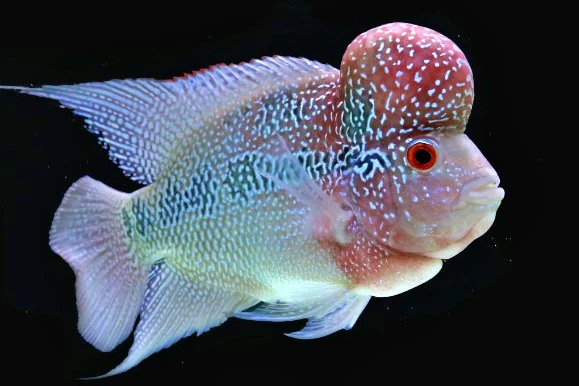
| Scientific name | Amphilophus hybrid |
| Diet | Algae, shrimp, aquatic plants, and biofilm |
| Size | 30-40 cm |
| Location | Taiwan |
Flowerhorn cichlids are known for their vibrant colors and striking features.
They have notably shaped heads, which are referred to as nuchal humps, giving them an unusual and eye-catching appearance.
Flowerhorn cichlids are hybrid fish resulting from the crossbreeding of different cichlid species.
They thrive in a tank with a minimum capacity of 40 gallons, although larger tanks, such as 75 gallons or more, are optimal.
Their sexual dimorphism has helped breeders keep their population in check.
While the males are typically larger and display more vivid and colorful patterns and have the distinctive nuchal hump on their foreheads the females have black dots on their dorsal fins and often exhibit an orange belly, especially when ready to breed.
3) Jack Dempsey
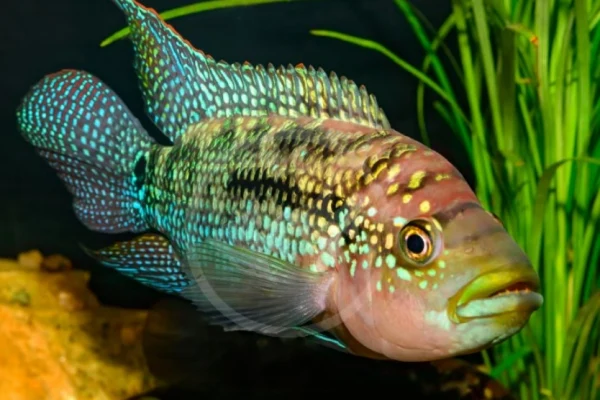
| Scientific name | Rocio octofasciata |
| Diet | Small insects, larvae, and small crustaceans |
| Size | 25 cm |
| Location | North and Central America |
Jack Dempsey are medium-sized living rainbows that add an amazing touch to your house. Their vibrant and iridescent scales showcase a stunning blend of colors, including various shades of blue, green, and pink.
They are known for their hardiness, making them a great choice for both beginner and experienced fish enthusiasts.
You’ll often find them exploring their surroundings, digging into the soil, and interacting with their environment.
4) Mandarin Fish
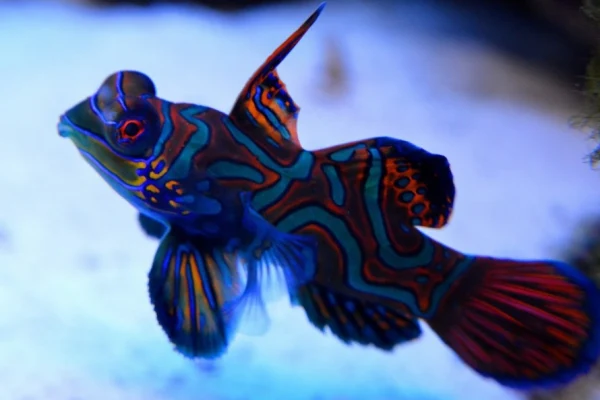
| Scientific name | Synchiropus splendidus |
| Diet | Polychaete worms, small gastropods, Gammaridean amphipods, fish eggs, and ostracods. |
| Size | 6 cm |
| Location | Native to the Pacific |
The mandarin fish, also known as the mandarin dragonet, is a true underwater gem as it showcases an array of vibrant colors.
Their bodies are adorned with a mosaic of black, pink, and blue spots against a light gray-green background.
Mandarin fish are natural reef dwellers and thrive in sheltered lagoons and inshore reefs.
As bottom feeders, they contribute to the balance of the reef by foraging on small crustaceans and invertebrates, showcasing both beauty and ecological value.
They have slime-covered bodies that not only protect them from diseases but also add an eye-catching layer of sheen.
5) Klunzinger’s Wrasse
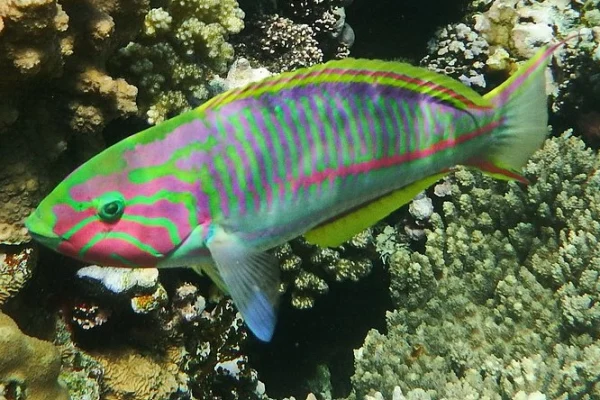
| Scientific name | Thalassoma rueppellii |
| Diet | Mantis shrimp, bristle worms, and small crustaceans |
| Size | 20 cm |
| Location | Red sea |
Klunzinger’s Wrasse, also known as Rüppell’s wrasse makes a wonderful choice for your aquarium.
Their bodies are adorned with vibrant shades of aqua green and are embellished with intricate, maze-like purple and pink lines on both the head and body.
Their active nature and constant movement always keep the aquatic display lively.
To ensure their health, provide a variety of foods, including vitamin-enriched frozen and dry options.
6) Pink salmon
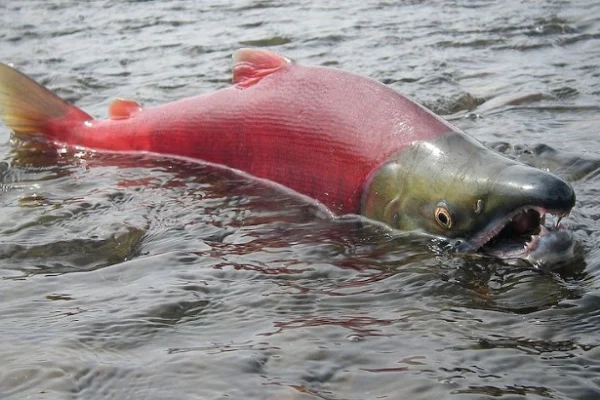
| Scientific name | Oncorhynchus gorbuscha |
| Diet | Invertebrates, zooplankton, and larvae |
| Size | 76 cm |
| Location | Pacific and Arctic coastal regions |
Also known as humpback salmon, pink salmon exhibits a fascinating natural coloration.
When in the ocean, they are bright silver but as they return to spawn in freshwater streams, their appearance changes to a pale grey sometimes even green on the back with a yellowish and white belly.
Pink salmon are the smallest and most abundant of the seven recognized salmon species.
Their eggs and carcasses support the growth of other fish species and contribute to the overall health of the ecosystem.
While pink salmon are not typically kept as pets, they are truly nature’s beauty.
7) Pink tail triggerfish
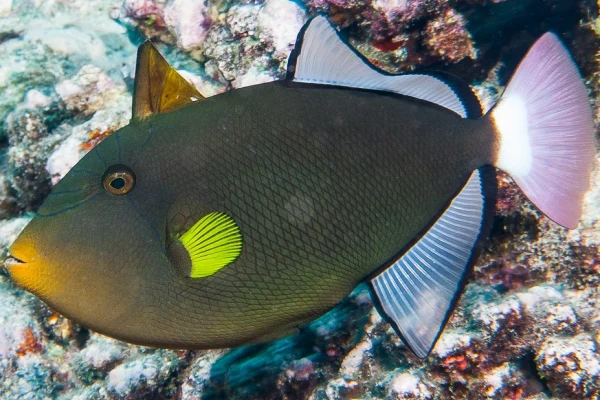
| Scientific name | Melichthys vidua |
| Diet | Squid, krill, clams, small fish, and hard-shelled shrimp |
| Size | ~40 cm |
| Location | Indo-Pacific |
The Pink Tail Triggerfish has an eye-catching emerald-green body with a vibrant pink tail, adding a beautiful contrast to the green.
Pink Tail Triggerfish is known for its aggressive behavior and needs a capacity of at least 180 gallons to provide ample space for swimming and exploration.
It is important to feed them with a diet that includes squid, krill, clams, small fish, and hard-shelled shrimp helping them wear down their ever-growing teeth, ensuring their well-being in captivity.
8) Redhead cichlid

| Scientific name | Vieja melanurus |
| Diet | Planktons, and small insects |
| Size | 35 cm |
| Location | Atlantic River drainages in Southern Mexico |
Often referred to as the quetzal cichlid, the Redhead cichlid showcases a stunning and vibrant coloration that makes it a prized addition in aquariums.
Adult redhead cichlids exhibit an eye-catching orange to pinkish-red head, creating a striking contrast with their greenish, bluish, pink, and golden-orange body.
A horizontal black bar, often patchy, is typically present at the base of their tail.
They show a certain degree of sexual dimorphism in terms of their appearance. Males are generally larger and develop a prominent nuchal hump on their forehead while the females are smaller and lack the hump.
Due to their stunning coloration, unique features, and relatively peaceful temperament, redhead cichlids are a favorite among aquarium enthusiasts.
9) Bridled parrotfish
| Scientific name | Scarus frenatus |
| Diet | Zooplankton, plankton, and small insects |
| Size | 47 cm |
| Location | Indo-Pacific regions |
Bridled parrotfish can be, in my opinion, the best pet fish to have in your fish haven!
It displays a wide array of colors throughout its life cycle. In its initial phase, it displays a reddish to-brown coloration adorned with six to seven dark, horizontal stripes along its body.
As they mature, the posterior of their body and the lower half of the head become noticeably lighter, and their caudal fins transform into a blue and green hue with large, crescent-shaped orange and pink areas.
In aquariums, they can contribute to maintaining a healthy and balanced ecosystem by helping to control algae.
10) Bicolor parrotfish
| Scientific name | Cetoscarus bicolor |
| Diet | Mainly algae |
| Size | 50 cm |
| Location | Red sea |
Bicolor parrotfish display a dark brown body with a large cream patch on the upper part during its initial phase.
It is during the terminal phase, that it becomes amazingly colorful, showcasing an overall green hue adorned with pink spotting on its body and fins.
Like many other parrotfish species, Bicolor parrotfish exhibits sequential hermaphroditism.
It starts as a female in its initial phase and then transforms into a male during its terminal phase.
Conclusion
This marks the end of yet another step toward unveiling the mysteries of nature (and, to some extent, the greed of humans) in the creation of these beautifully colored aquatic creatures.
The underwater world remains enigmatic, with numerous unexplored discoveries, not to mention unspoken ones. I hope this article has shed light on the various types and varieties of pink and green fish available for your aquarium.
Also Read:

Hi everyone, my name is Shawna, and I’ve always been fascinated by the fascinating diversity of flora and fauna that our nature has in it. I am currently studying biotechnology and am particularly interested in animal biotechnology, delving into the intricate processes that define their true nature and uniqueness.
